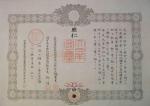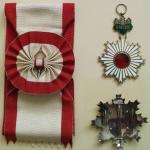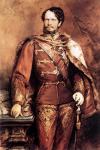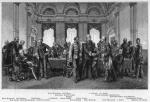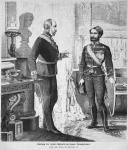-
Posts
22,214 -
Joined
-
Last visited
-
Days Won
68
Content Type
Profiles
Forums
Blogs
Gallery
Events
Store
Everything posted by JapanX
-
When I first time saw this set I was like WHAT?! IS THIS FOR REAL?! :beer:
-
Ok guys... Seriously... Cheers Paul! Nick
-
Indeed it is a beautiful and rare piece of history! Many thanks to Pieter for sharing this beauty with us! Cheers, Nick
-
The translation of the document (many thanks to Pieter for making it!) We, under the grace of Heaven, and descendent of an unbroken line of succession, have nominated the Imperial Austrian and Royal Hungarian Privy Councilor Julius Count Andrassy, in the First Class of our Meiji Order of the Rising sun, and We confer herewith the insignia of the order as a token of Our esteem. Given in the 2540th year after the accession to the throne of Emperor Jimmu, the 13th year, 6th month, 7th day of Our reign, at the Tokyo Palace, under Our Sign Manual and affixed with the Seal of State. Prime Minister, Councillor of the Bureau of Imperial decorations, First class of the Order of the Rising sun, Sanjo Sanetomi Entered under number 174 in the Registrar of Orders. So this was only 174th order of rising sun issued for foreigner back in June 7, 1880.
-
Some close-up’s of obverses.
-
Ok. Now its time for the highlight of this thread! First – general view of the set (nice rare box for the foreigner/prince of blood in excellent condition!).
-
Common rumor has it that Count Andrassy had a long romance with Queen Elisabeth (Sissy), the wife of Emperor Franz-Joseph, and fathered their only son Archduke Rudolf. There is no concrete evidence for this story, except that Elisabeth had a strong sympathy for Hungary, spent often time in Budapest, away from the court in Vienna, and could speak fluent Hungarian. She became famous worldwide in the late fifties with the Sissy films, starring Romy Schneider as Empress Elisabeth. Andrassy also features prominently in these films.
-
Here we have later photo of the Count. This one was made in (or shortly before) 1884. Already Grand Cordon was in his possession for 4 years.
-
Following his resignation, Andrássy withdrew from most political activity and died on February 18, 1890, at Volosca in Istria. He was a man of culture, refinement, aristocratic charm, and broad European outlook. His younger son of the same name (with whom he is often confused) was a distinguished statesman in his own right.
-
But not all publications were so kind to our hero. This is a nice example of classical english caricature on Count that was published back in 1877.
-
And this is the most famous portrait of our hero. It was painted by Benczúr Gyula (1844-1920) in 1884 and now in possession of Magyar Nemzeti Múzeum in Budapest.
-
This black and white reproduction of the same picture (I believe this is from some exhibition catalog issued back in 1880s) has helpful "who is who" captions.
-
This picture titled “Congress of Berlin, 13 July 1878” was painted by Anton von Werner (1843–1915) shortly afterwards.
-
At the Congress of Berlin (1878) Andrássy secured the right to occupy Bosnia-Herzegovina. From his viewpoint this action was aimed at counterbalancing Russia's increased role in the Balkans, while also taking account of his compatriots' wish to limit the number of Slavs in the empire. Although this "occupation" (turned into "annexation" in 1908) satisfied Austria-Hungary's immediate political interests, in the long run it proved to be a serious mistake, which contributed much to the eventual dissolution of the empire. For Andrássy personally, its ill effects were more immediate. Domestic dissatisfaction with the policy of expansion, coupled with the difficulties of the occupation itself, led to his resignation in 1879. But before he left office, he capped his career with the conclusion of the Dual Alliance (1879), which united Germany and Austria-Hungary and thus was the ultimate fulfillment of his foreign policy.
-
This nice gravure depicts a friendly chat (or maybe not so friendly after all) that our hero had with German Emperor William I back in 1872
-
Receiving amnesty in 1857, he returned to Hungary and joined forces with the middle-of-the-road liberals. Together with Francis Deák and Count Beust, he participated in the preparation and execution of the Austro-Hungarian Compromise of 1867. This agreement established the Austro-Hungarian Monarchy, or Dual Monarchy. Andrássy was appointed prime minister and minister of defense of the new Hungarian government. He was convinced that Hungary's territorial integrity was gravely endangered by Russian-supported nationalistic stirrings among the empire's Slavic minorities and by Russia's own designs on the Balkans. He sought to neutralize this danger by strengthening and perpetuating the German-Hungarian leadership in the monarchy and by increasingly relying on Germany's support. In 1871 Andrássy became foreign minister of the Dual Monarchy, and he worked with much success to strengthen the empire's international position. In the interest of this policy, he agreed to a partial rapprochement with Russia in the form of the Three Emperors' League (1872), but he made certain that Austria-Hungary's interests would be protected in the Balkan entanglement that followed the crisis of 1875.




